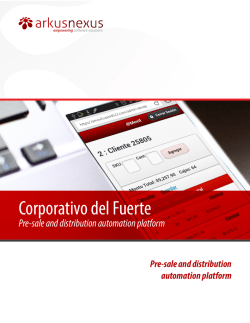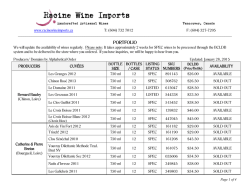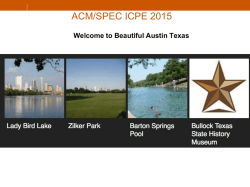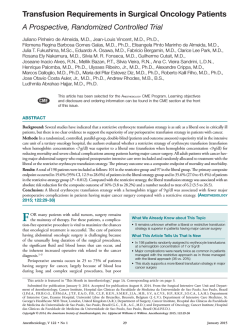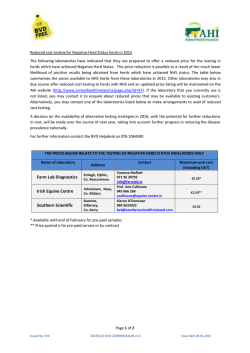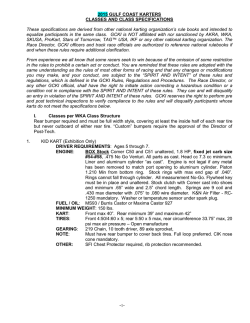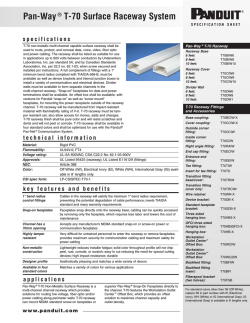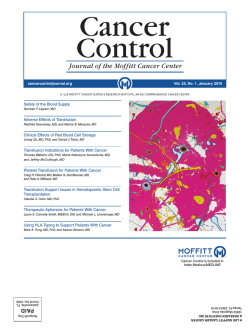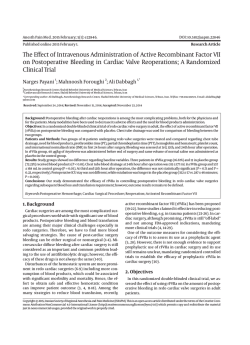
to view article - Mid-Ohio Valley Medical Group
Special Spotlight inSights SPOTLIGHT: LABORATORY EXCELLENCE AWARD COLA continues to feature a laboratory that has shown excellence not only in their compliance with accreditation standards, but also overall high quality patient care. COLA Accredited laboratories that meet the Laboratory Excellence Award (LEA) have had zero citations on their survey; no unsuccessful Proficiency Testing (PT) for any regulated analyte/subspecialty/ specialty for the last two years and had no substantiated complaints for the past two years. MID OHIO VALLEY MEDICAL GROUP LABORATORY Vienna, WV Laboratory Director: R. Randal Heavner, MD Technical Consultant/ Laboratory Manager: Marcia Campbell, vMT(ASCP) 11 C O L A’ S inSights About the Lab: Mid Ohio Valley Medical Group Laboratory has been accredited by COLA since 1992. Throughout the years we have seen many changes, including a name change (formerly Rosemar Medical), two moves, and the addition of several physicians. Our director, Dr. Heavner has been with us since our inception. We are a physician owned laboratory for sixteen Family Practice Physicians and four Nurse Practitioners, and also provide services for other nearby specialties. Our dedicated staff consists of the laboratory director, manager, six medical laboratory technicians, seven phlebotomists, and three secretaries. We are moderately complex, and do over half a million tests per year. Recently we added services for our after hours clinic and Saturday phlebotomy. In addition to the main laboratory, we staff three phlebotomy locations. Testing is performed in the areas of hematology, chemistry, immunoassay, coagulation, urinalysis, and immunology, and microscopy. Located along the Ohio River, we deliver care to our patients NOVEMBER/DECEMBER - 2014 from both West Virginia and Ohio, including rural outlying communities. Our mission is to provide excellent service to our patients, and our long relationship with COLA helps us to achieve a high level of quality care. Eighteen year employee Kara ZimmerRoof, MLT(ASCP), phlebotomy services manager, states: “I couldn’t be happier working anywhere other than MOVMG. It is extremely rewarding for me to be a team member in one of the area’s top facilities. I consider myself lucky to be part of this state of the art health care organization.” COLA’S NOVEMBER/DECEMBER — 2014 inSights in Transfusion Services and Mass Spectrometry ALSO IN THIS ISSUE: Letter from the Chair . . . . . . . . . . . . . . . . . . . . . . . . . . . . . . . . . 1 COLA CRITERIA OVERVIEW: Immunohematology and Transfusion Services. . . . 2 Guidance on Facilities that Provide Transfusion Services. . . . . . . . . . . . . . . . . . . 4 COLA Technical Bulletin 2014-4: New Criteria for Mass Spectrometry . . . . . . . . . . . . . . . 7, 8 COLA Technical Bulletin - 2014-5: Updates to Survey Criteria - IH & TS. . . . . . . . . . . . . . . 9, 10 inSights SPOTLIGHT: Laboratory Excellence Award. . . . . . . . . . . . . . . . . . . . . . . 11 Introducing COLA Criteria for Mass Spectrometry. . . . . . . . . . . . . . . . . . . . . . . . . . . . . . . . 12 Tandem Mass Spectrometry: The Gold Standard Explained . . . . . . . . . . . . . . . . . . . . . . . . 13 Beyond the Instrument: What is essential for quality Mass Spectrometry in the laboratory. . . . . . . . . . . . . . . 16 Advertisements . . . . . . . . . . . . . . . . . . . . . . . . . . . . . 2, 3, 5, 6, 15 FROM THE CHAIR This issue of COLA InSights into Transfusion Services and Mass Spectrometry takes a look at two of the most technical specialties that COLA laboratories perform. This issue contains articles on the Accreditation criteria that affect them as well as astute education on how these tests are performed. Richard A. Wherry, M.D. Chair, COLA Board of Director In the July 2014 version of the COLA Accreditation Manual there are the following revisions to Immunohematology and Transfusion Services criteria IH 2, IH 3, IH 6, IH 7, IH 10, TS 13, TS 17, TS 25, TS 76, TS 80, and TS 84. COLA CRITERIA OVERVIEW: Immunohematology and Transfusion Services outline some of these revisions and how they directly affect the laboratory. The 2014 criteria also include the acceptance of an Individualized Quality Control Plan (IQCP) for Quality Control of these test methods and there will be further articles on best practices forthcoming. Many questions are posed to COLA regarding how to classify and document different blood based activities in the laboratory. Guidance on Facilities that Provide Transfusion Services identifies key criteria for the various sites that perform testing on blood products. Also provided in this issue is the COLA Technical Bulletin - 2014-5: Updates to Survey Criteria – IH & TS which is also available on COLACentral under Educational Resources. Mass Spectrometry is beginning to be offered in POL and smaller laboratories and COLA has provided criteria for the first time on these test systems. Introducing COLA Criteria for Mass Spectrometry provides a wonderful overview into Mass Spec and the duties of COLA Accredited laboratories to be compliant. Due to the highly specialized nature of the testing a Technical Supervisor is required by COLA as part of the Accreditation Criteria. Beyond the Instrument: What is Essential for Quality Mass Spectrometry in the Laboratory expounds on what other than the instrument itself should be considered in proper utilization of Mass Spec testing. Tandem Mass Spectrometry: The Gold Standard Explained enlightens readers on what tandem mass spec is and also its applicability in smaller laboratories. Finally COLA Technical Bulletin 2014-4: New Survey Criteria – MSPEC is included for reference and is also available on COLACentral under Educational Resources. The November/December 2014 Issue of InSights in Transfusion Services and Mass Spectrometry showcases the highly technical testing that COLA accredited laboratories perform on a daily basis. COLA laboratories commitment to excellence in laboratory medicine directly translates to quality patient care. We encourage you to share with your lab and colleagues. COLA INSIGHTS COLA is sponsored by the American Academy of Family Physicians (AAFP), the American Medical Association (AMA), the American Osteopathic Association (AOA), and the American College of Physicians (ACP); and is endorsed by 29 national and state medical organizations. Letters to the editor are welcome. ADVERTISING POLICY COLA accepts advertising requests for inclusion in its publications. All advertisements are subject to review and approval by COLA. COLA reserves the right to reject or cancel any advertisement that is not in keeping with COLA’s standards as a national accreditation organization and its publication standards. COLA and its publications do not and will not endorse, directly or indirectly, any advertiser’s products or services. If you would like to discuss advertising opportunities, please contact COLA at 410.381.6581, ext. 3736. © COLA 2012 COLA INSIGHTS is published periodically by CRI®, 9881 Broken Land Parkway, Suite 215, Columbia, MD 21046-1195. COLA INFORMATION RESOURCE CENTER: 800.981.9883 This publication may be obtained through enrollment in a COLA accreditation program. ALL RIGHTS RESERVED Reproduction in whole or in part without written permission is prohibited. www.cola.org www.LabUniversity.org www.COLAcentral.com www.criedu.org Comments? Questions? Feedback? email [email protected] 1 C O L A’ S inSights NOVEMBER/DECEMBER - 2014 COLA CRITERIA OVERVIEW: Immunohematology and Transfusion Services1 The 2014 COLA Accreditation Manual includes a wealth of information regarding your laboratory’s operation and oversight. The general Immunohematology criteria address requirements for blood typing and antibody screens, and the appropriate control procedures for these tests. If your facility transfuses blood products, there are additional “TS” criteria in a separate Immunohematology and Transfusion Services section (following the Quality Assessment criteria) that apply to you. In addition to the general Criteria and Self-Assessment questions, there is a separate set of Criteria and SelfAssessment questions that only applies if your laboratory performs compatibility testing, antibody identification, OR if your facility transfuses blood products to patients. This set of criteria is divided with section headings that indicate the aspect of laboratory operation being addressed. For example, the Immunohematology and Transfusion Services questions have sections for: • Management • Storage, Transportation, and Dating • Quality Control • Recipient Testing for Transfusion • Computerized Systems • Recipients with Special Needs • Dispensing Requirements • Units for Reissue • Transfusion Reactions • Record Keeping and Documentation RESOURCES: 1. COLA Accreditation Manual – Revised July 2014, p.147 Leading the way for quality testing solutions • Quality- excellent correlation to reference methods and minimum lot-to-lot performance variability • Choice- more than 100 clinical assays available as well as different reagent formats and method options • Flexibility- applications with instrument specific settings enable Randox reagents to be easily run on a wide variety of clinical analyzers • Range of speciality reagents- including Cystatin C, Fructosamine, Homocysteine and Lipoprotein(a), taking testing beyond the routine Randox Laboratories-US Limited, 515 Industrial Boulevard, Kearneysville, West Virginia, 25430 T: (+1) 866 4 RANDOX F: (+1) 866 RANDOX 1 E: [email protected] Learn more at randox.com randox.com/diagnostic-reagents.php AV1564 COLA AUG14.indd 1 30/07/2014 16:28 COLA Technical Assistance 800.981.9883 | www.cola.org | www.LabUniversity.org | www.COLAcentral.com 2 Patient Centered Laboratory Excellence (PCLE) COLA is proud to introduce the Patient Centered Laboratory Excellence program (PCLE). This groundbreaking program is specially designed to assist laboratories in participating in the Patient-Centered Medical Home & ACO Models of care and to be recognized for their efforts. Through the PCLE program, COLA is taking laboratory quality beyond the confines of CLIA 88 by expanding its accreditation services to include waived testing labs. The PCLE Program helps waived and non-waived laboratories: • Achieve a continuous quality culture in the lab • Integrate best practices into the PCMH/ACO model • Make better informed, needs appropriate resource decisions • Gain recognition from payer incentive programs COLA’s PCLE program is scalable to fit the needs of all laboratories, no matter the annual test volume, number of specialties performed or certificate type. PCLE brings laboratories multiple benefits: • Provides a continuous quality framework designed to support the lab’s involvement in the PCMH/ACO care models • Positions laboratories to participate in PCMH/ACO quality incentives • Criterion is scalable and meaningful to practice operations • A PCLEexcelerator scoring mechanism enables labs to evaluate their readiness to participate in the PCMH/ACO model • Focuses on communication, regulatory requirements, test selection, analytics and other key elements that are necessary for PCMH/ACO success Enrollment in COLA’s PCLE program is the first step in your laboratories successful participation in a PCMH/ ACO program and receiving a “Gold Seal of Approval” in laboratory excellence as a PCLE Laboratory. PCLE recognition will set your laboratory apart and could lead to gaining recognition from payer incentive programs. It’s time for your lab to participate in the PCMH program that has been designed for laboratories by COLA, the experts in laboratory medicine. Let COLA’s PCLE program help your laboratory find success in many ways in the Patient Centered Medical Home model. To learn more about PCLE call COLA at 800-981-9883 or visit: www.cola.org/patient-centered-laboratory-excellence-pcle/ and see our new PCMH Whitepaper 3 C O L A’ S inSights NOVEMBER/DECEMBER - 2014 Guidance on Facilities that Provide Transfusion Services Reprinted from COLA’s Accreditation Manual, revised July 2014. © 2014 COLA INTRODUCTION The following standards and criteria are applicable to any facility involved in the provision of transfusion services. This includes facilities that do not perform testing within the specialty of Immunohematology, but administer blood products to patients. Facilities requiring FDA Registration: • Those that engage in the manufacture of blood products, to include the collection, component preparation, product testing, labeling, storage, and distribution of blood products. • Those that manipulate blood products including irradiation, freezing, deglycerolizing, and washing cells. • Facilities that are approved for Medicare reimbursement may be exempt from FDA Registration if their services are limited to the following items. (CFR 607.65 f): • Engage in compatibility testing and transfusion of blood products, but neither routinely collect nor process blood and blood components. • Those that may collect and process blood and blood components only in an emergency situation as determined by a responsible person and documented in writing. • Those that perform therapeutic collection of blood or plasma that is not intended for transfusion. • Those that solely prepare Red Blood Cells or Recovered Plasma, pool Platelets or Cyroprecipitated AHF for ease of transfusion, or issue bedside leukocyte reduction filters. NOTE: The blood products described above, must be intended for use within the facility. If the facility were to send the product to another facility, FDA registration is required. For additional information contact the Center for Biologics Evaluation and Research at the FDA. (By phone 301-827-3546 or email [email protected] ) There are several types of facilities involved in the provision of transfusion services. Blood Banks: A facility that collects and/or processes blood products in preparation for transfusion. Such facilities may also distribute blood products to outside facilities, perform immunohematology testing and administer blood products to patients. Transfusion Services: A facility that is not involved in the collection or processing of blood products, but is involved in the administration of blood products to patients. COLA FURTHER DIVIDES TRANSFUSION SERVICES INTO TWO CATEGORIES. 1. Full Transfusion Service: A facility performs immunohematology testing and administration of blood products. 2. Blood Storage & Administration: A facility that does not perform immunohematology testing on site, but receives and administers blood products. For these facilities not all criteria contained in this document will be applicable considering the limited level of service. COLA Technical Assistance 800.981.9883 | www.cola.org | www.LabUniversity.org | www.COLAcentral.com 4 COLA Accreditation includes an evaluation of laboratory policies, processes, and records associated with the following: • Laboratory testing performed on potential blood donors (such as hemoglobin and hematocrit) • Laboratory testing performed on blood components (such as ABO& Rh, HIV, hepatitis, etc...) • Laboratory testing of blood products for compatibility with an intended recipient (such as ABO & Rh, Antibody screening, compatibility, etc) • Storage of blood products • Dispensing blood products for intended transfusion • Basic requirements associated with administration of the product to the intended recipient • Investigation of suspected transfusion reactions and associated laboratory testing (such as ABO & Rh, DAT, haptoglobin, etc...) COLA Accreditation does not include evaluation of policies, processes, and procedures associated with donor suitability, collection of the blood product, manufacturing (processing) the blood product, or recall of blood products or donors. SAVE THE DATE! We look forward to seeing you at the next CRI® ANNUAL SYMPOSIUM FOR CLINICAL LABORATORIES! Mark your calendars for: October 7 - 10, 2015 Tropicana | Las Vegas, NV 5 C O L A’ S inSights NOVEMBER/DECEMBER - 2014 CRI® IQCP Workshop Attendee Follow Up Greetings IQCP Workshop Participant, On behalf of CRI® I would like to again thank you for participating in our first CRI® IQCP Workshop in Orlando! Our expectation is that the IQCP Workshop provided much needed information, insight and confidence for you to create and implement an IQCP for your laboratory. As a Thank You, CRI® is extending an EXCLUSVE offer to the IQCP Workshop participants. Please visit our website www.criedu.org Enter Coupon Code: CRIIQCP50 at checkout and receive an instant $50 discount on the CRI® IQCP E-Optimizer and IQCP Implementation Guide. This exclusive coupon code will only be active until December 31,2014! Remember to visit our websites www.criedu.org or www.labuniversity.org to access our complete portfolio of IQCP products: • CRI® IQCP E-Optimizer • IQCP Implementation Guide • IQCP Workshop Series* • IQCP Webinars* • CRI® Educational Video: Implementing an IQCP (Individualized Quality Control Plan) • Webinar CEexpress 21: COLA Update – Individualized Quality Control Plans* • Webinar CEexpress 22: Everything You Wanted to Know About IQCP* • Risk Management in the Clinical Laboratory* • LabGuide 53: Individualized Quality Control Plans * P.A.C.E.® credit and/or CME credit earned as indicated upon registration. In addition, CRI® is excited to announce our upcoming series of IQCP Webinars and Workshops, presented by leading experts in the field of IQCP, including Judy Yost, CMS’ Director of the Division of Laboratory Services. Program schedule and details will be available on our website: www.criedu.org and www.labuniversity.org Our mission at CRI® is to “Provide educational and consultative services aimed at improving laboratory medicine and patient care.” We would like to thank you for your support of our mission and look forward to our continued partnership as we work to meet this mission. Respectfully, Rose Mary Casados CRI® President COLA Technical Assistance 800.981.9883 | www.cola.org | www.LabUniversity.org | www.COLAcentral.com 6 ISODOC – 53-26 Effective Date: July 7, 2014 2014 2014-4: New Survey Criteria - MSPEC MSPmmmmm11MMSPECSsSsSpec COLA periodicallyGroup reviews the criteria for accreditation, and makes changes to the criteria and/or related annotations for several reasons. ! ! To clarify language, so that the intent of the criterion is clear. To incorporate new information, which may be in response to changes in technology or regulatory emphasis. Updates from the most recent review will be effective as of 7/7/2014. Based on the most recent review, COLA is adding several new criteria to accommodate those labs that perform testing for drugs of abuse by mass spectrometry. The criteria have been added to clarify the requirements and how to fulfill them. In the clinical laboratory setting, whether part of a physician’s office laboratory or the hospital clinical laboratory, good laboratory practice and quality patient care are key objectives. MSPEC 1 R Does the laboratory have a written procedure, approved by the Laboratory Director, for check tuning each mass spectrometer which includes acceptance parameters and frequency requirements? At a minimum, the lab must perform electronic tuning at the frequency recommended by the manufacturer. The procedure should include the indicators that would constitute the need for a check tune beyond the established frequency. Tuning must be documented and maintained. MSPEC 2 R Does the laboratory have a written procedure, approved by the Laboratory Director, for the performance of mass calibration, which includes acceptance parameters and frequency requirements? Mass calibration should be performed minimally at the frequency specified by the manufacturer, if applicable, or for troubleshooting purposes when QC or other routine quality checks do not fall within established parameters. The procedure should include the indicators that would constitute the need for a mass calibration beyond the established frequency. Mass calibration must be documented and maintained for two years. MSPEC 3 E For each reportable analyte, has the laboratory evaluated the specimen matrix for ion suppression? As part of the method validation for each analyte, interference caused by ion suppression should be evaluated using an isotope-labeled standard. The Laboratory Director must review the ion suppression studies to evaluate recovery of the internal standard and make appropriate adjustments to procedures for identification and quantification of the target analyte. Ion suppression studies must be repeated if there is a change in specimen type for any given analyte. tive EffectiveEffective Date: 6/03 ISODOC – 53-20 7 C O L A’ S Comments? Feedback? Questions? EmaEil us at [email protected] or call us at 800 981-9883 inSights NOVEMBER/DECEMBER - 2014 COLA Technical Bulletin 2013-2 COLA Technical Bulletin 2013-2 COLA Technical Bulletin 2014-4 p. 2 p. 2 p. 2 p. 2 MSPEC 4 R Does the laboratory procedure for each analyte reported using mass spectrometry include specific identification criteria approved by the Laboratory Director? The procedure must include the laboratory’s criteria for evaluating the mass spec chromatogram, based upon credible reference materials or the laboratory’s own validation studies. Identification criteria may include, if applicable, tolerance limits for ion ratios, and evaluation of the presence of expected “daughter” molecules. Identification criteria should be specific to each analyte reported. MSPEC 5 R Are all sample chromatograms reviewed for accuracy prior to release of the patient report? Chromatograms must be reviewed for accuracy by qualified high complexity testing personnel who have documented training and competency assessment. MSPEC 6 E If the laboratory uses a cutoff value for reporting positive or negative, do the quality control materials used for each analyte include one with an expected result that is below the positive cutoff value and one with an expected result that is above the positive cutoff value? In order for QC to be relevant, materials that challenge the positive cutoff or decision point, on both sides, should be used. This criterion also applies to other methods that have a positive cutoff value. MSPEC 7 R Does the person designated as Technical Supervisor for the mass spectrometry have the CLIAdefined qualifications for the position plus at least one year of training and/or experience specifically in mass spectrometry? The Technical Supervisor is a critical position in the mass spectrometry laboratory. Due to the unique expertise required for accurate results in a mass spec lab, COLA requires that the Technical Supervisor have specific documented training or experience related to the clinical use of mass spectrometry. In order to meet the CLIA-defined responsibility of competency assessment, the Technical Supervisor must be well-versed in the day to day operation and critical review of mass spec data. COLA Technical Assistance 800.981.9883 | www.cola.org | www.LabUniversity.org | www.COLAcentral.com Effective Date: 7/7/2014 8 ISODOC – 53-28 Effective Date: 7/7/2014 2014-5: Updates to Survey Criteria – IH & TS COLA periodically reviews the criteria for accreditation, and makes changes to the criteria and/or related annotations for several reasons. ! To clarify language, so that the intent of the criterion is clear. ! To incorporate new information, which may be in response to changes in technology or regulatory emphasis. Updates from the most recent review will be effective as of 7/7/2014. Based on the most recent review, COLA is adding two new criteria to accommodate those labs that perform immunohematology testing or offer transfusion services. In addition, several existing criteria have been updated for clarification. In the clinical laboratory setting, quality laboratory medicine and patient care are key objectives. The COLA criteria are designed to not only keep you in compliance with the regulations, but to help you provide quality laboratory services for excellence in patient care. NEW CRITERIA IH 12 R Are criteria for interpretation of reactivity defined in the laboratory procedures? It is important to ensure that all testing personnel are using the same grading criteria to interpret and record results. TS 44.1 R If IgG gel technology is used for crossmatch, is an alternate method used and documented to detect ABO incompatibility? Compatibility testing using IgG gel technology has not been FDA approved for detecting ABO incompatibility. It is therefore necessary to perform another acceptable method that would detect ABO incompatibility. An immediate spin tube crossmatch is one method that is commonly used for this purpose. EXISTING CRITERIA UPDATES IH 6 R TS 25 R Are Rh antisera checked with positive and negative controls each day of use and are the results documented? The following annotation has been added to these criteria: The negative control should be tested through the AHG phase if you are testing patients through the AHG phase, such as for neonates. tive EffectiveEffective Date: 6/03 ISODOC – 53-20 Comments? Feedback? Questions? EmaEil us at [email protected] or call us at 800 981-9883 9 C O L A’ S inSights NOVEMBER/DECEMBER - 2014 COLA Technical Bulletin 2013-2 COLA Technical Bulletin 2013-2 COLA Technical Bulletin 2014-5 p. 2 p. 2 p. 2 p. 2 TS 13 R Does an audible alarm sound indicating a power failure or other disruption of refrigeration? The following annotation has been added to this criterion: The alarm should be set to activate under conditions that will allow corrective action to be taken before blood components or derivatives reach unacceptable temperatures. TS 80 R The criterion has been re-worded for clarity: Does the written transfusion reaction investigation procedure define circumstances that would require additional testing and describe what additional testing would be performed? The following annotation has been added to this criterion: For example: • Culturing for potential contamination if clinically indicated • Antibody identification if post transfusion DAT is positive In addition, minor changes have been made to the wording or format of the following criteria and /or annotations: IH 2 IH 3 IH 7 IH 10 TS 17 TS 76 TS 84 Please watch for the upcoming announcement about the revised COLA Accreditation Manual and be sure to download and review the new manual for further details. As always, call our technical staff at 800-981-9883 if you have any questions. Effective Date: 7/7/2014 COLA Technical Assistance 800.981.9883 | www.cola.org | www.LabUniversity.org | www.COLAcentral.com ISODOC – 53-28 10 Special Spotlight inSights SPOTLIGHT: LABORATORY EXCELLENCE AWARD COLA continues to feature a laboratory that has shown excellence not only in their compliance with accreditation standards, but also overall high quality patient care. COLA Accredited laboratories that meet the Laboratory Excellence Award (LEA) have had zero citations on their survey; no unsuccessful Proficiency Testing (PT) for any regulated analyte/subspecialty/ specialty for the last two years and had no substantiated complaints for the past two years. MID OHIO VALLEY MEDICAL GROUP LABORATORY Vienna, WV Laboratory Director: R. Randal Heavner, MD Technical Consultant/ Laboratory Manager: Marcia Campbell, vMT(ASCP) 11 C O L A’ S inSights About the Lab: Mid Ohio Valley Medical Group Laboratory has been accredited by COLA since 1992. Throughout the years we have seen many changes, including a name change (formerly Rosemar Medical), two moves, and the addition of several physicians. Our director, Dr. Heavner has been with us since our inception. We are a physician owned laboratory for sixteen Family Practice Physicians and four Nurse Practitioners, and also provide services for other nearby specialties. Our dedicated staff consists of the laboratory director, manager, six medical laboratory technicians, seven phlebotomists, and three secretaries. We are moderately complex, and do over half a million tests per year. Recently we added services for our after hours clinic and Saturday phlebotomy. In addition to the main laboratory, we staff three phlebotomy locations. Testing is performed in the areas of hematology, chemistry, immunoassay, coagulation, urinalysis, and immunology, and microscopy. Located along the Ohio River, we deliver care to our patients NOVEMBER/DECEMBER - 2014 from both West Virginia and Ohio, including rural outlying communities. Our mission is to provide excellent service to our patients, and our long relationship with COLA helps us to achieve a high level of quality care. Eighteen year employee Kara ZimmerRoof, MLT(ASCP), phlebotomy services manager, states: “I couldn’t be happier working anywhere other than MOVMG. It is extremely rewarding for me to be a team member in one of the area’s top facilities. I consider myself lucky to be part of this state of the art health care organization.” Introducing COLA Criteria for Mass Spectrometry Mass Spectrometry (or Mass Spec) is gaining popularity in the Physician Office Laboratory and smaller laboratories due to the wide array of manufacturers, instrumentation options and ease of use in comparison to older methods. Although it is a substantial investment there are many tests that can be performed right on a benchtop instrument. Diagnostic testing for drugs of abuse has increased exponentially and there is also testing being performed for detection of toxic “heavy” metals or hormones such as Free T4 and Free T3 during pregnancy1. Mass Spec, when performed properly, is a highly specific and highly sensitive method for detecting compounds of interest. COLA has added several new criteria for labs that perform testing for drugs of abuse by mass spectrometry. The criteria have been added to clarify the requirements and how to fulfill them. In the clinical laboratory setting, whether part of a Physician Office Laboratory or the hospital clinical laboratory, good laboratory practice and quality patient care are key objectives.2 COLA defines Laboratory Developed Tests (LDT) as tests which have been developed, from the ground up, by your laboratory, and cannot be purchased as kits or prepared reagent sets from suppliers. Unless specifically listed on the FDA CLIA test database, COLA considers tests that utilize mass spectrometry as Laboratory Developed Tests.3 COLA encourages the use of the Risk Assessment and implementation of Individualized Quality Control for Laboratory Developed Tests, in order to identify and mitigate errors throughout all phases of testing for these tests. However, the minimum regulatory QC requirements must still be met. LC-MS/MS is technology that has completely revolutionized the standard norms of diagnostics and the use of immunoassays. Laboratories can identify if the Return on Investment is worth bringing tests inhouse that are currently being sent out. When expenses are factored in the laboratory can review the pros and cons of performing Mass Spec on the bench top. COLA’s goal is that if laboratories choose to perform Mass Spec, it be performed properly and within the COLA Accreditation Criteria required. RESOURCES: 1. Thyroid Hormones Measured by Tandem Mass Spectrometry and Immunoassay with Thyroid-Stimulating Hormone. Podcast. © 2009 American Association for Clinical Chemistry. https://www.aacc.org/ events/podcast/Documents/072709Soldin.pdf 2. COLA Technical Bulletin 2014-4: New Survey Criteria - MSPEC 3. COLA Accreditation Manual – Revised July 2014, p.106-107 COLA requires adherence to the CLIA regulatory QC requirements for Laboratory Developed Tests, at a minimum, which in most cases is two levels of external QC each day of patient testing. Most labs performing mass spec analysis perform QC at a higher frequency than the CLIA regulatory requirement. Labs performing LDTs must also comply with requirements to establish performance specifications (see VER 5-11). COLA Technical Assistance 800.981.9883 | www.cola.org | www.LabUniversity.org | www.COLAcentral.com 12 Tandem Mass Spectrometry The Gold Standard Explained LC-MS/MS Tandem mass Spectrometry provides even more specificity as it makes two mass measurements within the instrument. Why is this important? A sample analyzed using LC-MS may have two peaks reporting on the same chromatogram for mass (same colored peak) but they have different peak times, therefore they are two different compounds that just happen to have the same mass and cannot be differentiated other than using retention time. This is why Tandem Mass Spec has become the Gold Standard for quantitation.1 Single state mass spectrometry LC-MS can measure single mass of the molecule of interest. The intact molecule is analyzed and the method does provide accurate measurement of compounds. The limitation is that there is much background in the data and also there is no differentiation of molecules of the same mass other than the retention time. LC-MS/MS measures mass of intact molecule in the first mass filter then subjects it to fragmentation in a collision cell. The fragments continue their journey to a second mass filter where the instrument can isolate the ion of interest. Using LC-MS/MS method the instrument can remove potential interference molecules that have the same mass. LC-MS/MS system allows for the measurement of enhanced parent mass and the diagnostic fragment mass. LC-MS/MS also has lower background which allows identification of trace or low concentrations of compound and provides enhanced specificity for identifying the molecule of interest. LC-MS/MS is the gold standard due to the high level of specificity using multiple criteria used to identify the ion such as retention time, mass of molecule and mass of characteristic fragment ion. LC-MS/MS is not subject to cross reactivity. For example- when detecting metabolites of vitamin D in a patient sample an antibody may recognize many different analytes with similar structural characteristics causing an unwanted reaction in a detection system. Using an immunoassay that lacks specificity there may be much cross reactivity 13 C O L A’ S inSights in that test system.2 Compounds having similar structures have different masses and thus will be differentiated in the Tandem system. Less need for repeat testing, and the instrument can analyze different compounds in different matrices (urine, serum) at different concentrations. LC-MS/MS shows the “chemical fingerprint” enables the definitive ID of a compound. By observing the unique fragmentation patterns of compounds there is definitive proof of its identity. No two compounds will have the same fragment pattern regardless of the intact molecule weight. Correlation studies have been performed with LC-MS/MS versus immunoassay where the slope of linearity was a factor 2.9X higher for the immunoassay due to lack of specificity and cross reactivity.3 This means that LC-MS/MS provides much greater specificity that directly translates to better patient care from more accurate testing results. Samples that can be analyzed are liquid samples such as plasma, serum, CSF, whole blood and urine, etc. Solid samples (tissue, soil, etc.) can also be processed if the analyte of interest can be extracted (ex. from homogenized tissue) and placed into a liquid medium. This liquid sample can be placed into the ionization source of the LC-MS/MS system. LC/MS-TOF compounds with the same nominal mass but different exact mass. LC/MS-TOF provides measurement of mass to four decimal places. Time-of-flight mass spectrometry (TOFMS) is a method of mass spectrometry in which an ion’s mass-to-charge ratio is determined via a time measurement. Ions are accelerated by an electric field of known strength.5 This acceleration results in an ion having the same kinetic energy as any other ion that has the same charge. The velocity of the ion depends on the mass-to-charge ratio. The time that it subsequently takes for the particle to reach a detector at a known distance is measured. This time will depend on the mass-to-charge ratio of the particle (heavier particles reach lower speeds). NOVEMBER/DECEMBER - 2014 From this time and the known experimental parameters one can find the mass-to-charge ratio of the ion. Using Time-ofFlight mass spectrometry, it is possible to: MS. In determining if a patient has used MDA or MDMA LC-MS/MS has the sensitivity to identify which compound is or isn’t present in the sample. In microbiology MALDI/TOF spectra are used for the identification of microorganisms such as bacteria or fungi. Mass Spec technology in any of these forms is a way for highly specialized identification of analytes that may directly impact the patient treatment plan. It could possibly provide a more accurate diagnosis of symptoms in a shorter timeframe, reducing length of stay, treatment duration and/or overall cost of care. Mass Spec is a tool that can benefit laboratories of any size in many ways. 1. collect data across a wide mass range without decrease in sensitivity, so that full scan spectra is achieved; 2. resolve interferences with high resolving power; and 3. achieve accurate mass measurements for the estimation of elemental composition 6 Matrix-assisted laser desorption/ionization (MALDI) is a soft ionization technique used in mass spectrometry, allowing the analysis of biomolecules (biopolymers such as DNA, proteins, peptides and sugars) and large organic molecules (such as polymers, dendrimers and other macromolecules), which tend to be fragile and fragment when ionized by more conventional ionization methods.7 Immunoassays will still continue to be used in many laboratories due to reliability of results, ease of use and lower cost in comparison to MS. Therapeutic drug monitoring (TDM) is an example of the popular use of immunoassays for the quantification of immunosuppressive drugs in samples from patients after organ transplantation.8 Many manufacturers are working feverishly to improve the specificity of immunoassays to rival that of MS. “The accuracy of either technology is reliant on calibration.” states Paul Taylor of the Department of Clinical Pharmacology and the University of Queensland, Princess Alexandra Hospital, Brisbane, Australia. “For immunoassay users, they are reliant on the manufacturer, but for LC-MS/MS, calibrators prepared in house are typically used. This type of in-house–prepared calibrator has the potential to lead to bias in results.”9 Resources: Basics of Mass Spectrometry and its use in the Clinical laboratory. Webinar. Sciex 1, 3. haracterizing antibody cross-reactivity for immunoaffinity C purification of analytes prior to multiplexed liquid chromatographytandem mass spectrometry. Clin Chem. 2012 Dec;58(12):1711-6. doi: 10.1373/clinchem.2012.185827. Epub 2012 Sep 11. 2. http://www.aacb.asn.au/documents/item/750 4. 5. Stephens, W. E., A Pulsed Mass Spectrometer with Time Dispersion Phys. Rev., 1946, 69, 691. 6. TIME OF FLIGHT MASS SPECTROMETRY APPLIED TO THE LIQUID CHROMATOGRAPHIC ANALYSIS OF PESTICIDES IN WATER AND FOOD. http://www.ual.es/~intercom/comun/ time.pdf Matrix-assisted laser desorption/ionization http://en. wikipedia.org/wiki/Matrix-assisted_laser_desorption/ ionization 7. 8. Clinical Chemistry May 2012 vol. 58 no. 5 821-825 Clinical Chemistry May 2012 vol. 58 no. 5 821-825 9. When would all of this highly specified technology be applicable in the Physician Office Laboratory or in a small clinic one might inquire? What can be detected by LC-MS/MS is an open ended question as the use of the instrument in each laboratory may vary. The use of detection of Vitamin D metabolites to drugs of abuse can be performed using LC-MS/ COLA Technical Assistance 800.981.9883 | www.cola.org | www.LabUniversity.org | www.COLAcentral.com 14 15 C O L A’ S inSights NOVEMBER/DECEMBER - 2014 Beyond the Instrument What is essential for quality Mass Spectrometry performance in the laboratory? COLA has put into effect new accreditation criteria for laboratories that perform Mass Spectrometry (MS). In addition to these new criteria there should be a sincere consideration of what a laboratory needs other than just the instrument for mass spec to be successful. This issue of InSights covers the various criteria for compliance but there are additional components that should be addressed when preparing to implement MS as a testing method in your laboratory. Some of the areas that will be included for consideration are • Personnel • Facility & Safety • Materials & Supplies • Validation, Calibration & Maintenance • Specimen preparation • Procedures Personnel Among the new COLA Accreditation Criteria for MS one of the most important is the need for a Technical Supervisor as part of the testing personnel. A Technical Supervisor is crucial in Mass Spectrometry (MS) labs due to the high level of oversight needed to ensure proper performance of procedures and accurate test results. When developing the personnel and training plan for the MS lab, elements to consider are: • Do you have in-house expertise to develop, validate methods and perform testing? • Have you taken advantage of any/all onsite training provided by the manufacturer? • Could your staff benefit from additional third party training? • Have you developed a meaningful training and competency assessment program for your MS testing personnel? MSPEC 7 R Does the person designated as Technical Supervisor for the mass spectrometry have the CLIA-defined qualifications for the position plus at least one year of training and/or experience specifically in mass spectrometry? The Technical Supervisor is a critical position in the mass spectrometry laboratory. Due to the unique expertise required for accurate results in a mass spec lab, COLA requires that the Technical Supervisor have specific documented training or experience related to the clinical use of mass spectrometry. In order to meet the CLIA-defined responsibility of competency assessment, the Technical Supervisor must be well-versed in the day to day operation and critical review of mass spec data.1 Facility & Safety A Site Planning Guide (SPG) is usually supplied by the Mass Spec manufacturer and contains information on things to take into consideration when planning the Mass Spec lab. These areas include space, electrical, gas supply, ventilation, computer connections, operating environment, reagents, supplies, tubing and fittings to HPLC. This document is helpful, but generally not sufficient to start a working Mass Spec lab. In addition to this list there could be additional components such as an uninterruptible power supply (UPS), gas generator (with appropriate capacity), fume hood, bar code printer, and LIS.2 In planning out the space there must be consideration for access to instruments for maintenance, and connecting the instruments to exhaust and waste collection areas. A safety officer should be consulted for proper disposal of all waste as even the spent reagent is hazardous waste. Appropriate venting is mandatory to comply with OSHA regulations for solvent and hydrocarbon exposure. Electrical considerations include not only a UPS, but also ensuring the proper voltage to >> CONTINUED ON PAGE 15 COLA Technical Assistance 800.981.9883 | www.cola.org | www.LabUniversity.org | www.COLAcentral.com 16 Beyond the Instrument What is essential for quality Mass Spectrometry performance in the laboratory? continued the equipment and making sure that the proper connections are being used. COLA Criteria FAC 1 & 2 address the requirements for facility design. When your instrument is installed, the above requirements should be documented as part of the installation qualification process. Ensuring manufacturer’s requirements for the operating environment are satisfied will promote longevity and proper functioning of the instrument. Materials & Supplies There are a number of questions the laboratory will need to answer in preparation for mas spec testing. What is the test system detecting and is the material of interest available in high purity from commercial sources? What matrix is going to be used and is there NBST certified calibrator material available? Is the laboratory going to “manufacture” buffers, calibrators and QC material? The accuracy of weights, measures, pipettes, flasks must all be taken into account. An expiration date for prepared reagents must be established and documented. COLA Criterion MA 1 identifies the requirements for labeling all reagents. Use HPLC or LCMS grade solvents or better, when selecting a brand or manufacturer try as best as possible to maintain continuity with quality. Don’t try to cut corners or costs if the quality may be compromised. If a brand or manufacturer changes a formulation, you must revalidate your methodology. QC review should be performed on all raw material and columns upon receipt and during daily use. Validation & Calibration The increase in the use of MS in smaller laboratories is testament to the considerable amount of compounds that can be identified using the instrument. Mass spec is not approved by the FDA for diagnostic testing as a class II device, but many manufacturers have their MS registered as a Class I device. As defined by the FDA “A laboratory developed test (LDT) is a type of in vitro 17 C O L A’ S inSights diagnostic test that is designed, manufactured and used within a single laboratory.”3 The MS instrument is most often used for LDT by the end user.4 This is important to understand due to the fact that many components that will be used for the test system, such as reagents, calibrators and controls, may be obtained from sources different from the source of the equipment. Equipment Set up and Maintenance In the majority of cases when a Mass Spectrometer is purchased the delivery and installation is performed by a manufacturer’s representative. There should be arrangements made for the laboratory to receive training on operation and maintenance by the manufacturer as well. Testing personnel should be knowledgeable about what to do once the rep walks out of the door. What if something breaks or how can the laboratory perform routine maintenance? Best practices would be to keep a set of appropriate tools available and spare parts if possible. If your laboratory orders two ink cartridges at a time to have one available when the one in the machine is empty, imagine how much easier it is to have an extra check valve, fitting , MS electrode, fuse or HPLC tubing available when that component fails. According to Dr. Geza Bodor of the University of Colorado Denver “An annual maintenance contract is mandatory for continuous operation.”5 Launching a new instrument involves 3 stages of implementation, Installation qualification (IQ), Operational qualification (OQ), and Performance qualification (PQ). Installation qualification (IQ)6 This is the first stage. It documents the completeness of shipping and components of the system, as well as the required environmental conditions to maintain the optimum working environment. It is recommended that laboratories have an IQ service performed at the following times: NOVEMBER/DECEMBER - 2014 • At the time of instrument installation • When an instrument is moved to another location or laboratory • After functionality such as a hardware or software upgrade is added to the system • After components are added to the system • Before a previously installed system will be used in a regulated test environment for the first time (e.g. an instrument used for basic research transitions for use in clinical trials research) Operational Qualification / Performance Verification (OQ/PV)7 Operational Qualification / Performance Verification (OQ/PV) ensures that the instrument functions correctly to the manufacturer’s specification. OQ/PV helps to qualify the analytical system for correct operation in the customer’s laboratory. The OQ/PV has to be renewed after moving the instrument to another location or laboratory. After a preventive maintenance (PM) service or a significant instrument repair the OQ/PV needs to be renewed. Operational Qualification is a recommended part of an end-to-end system qualification, and provides consistent performance qualifications that are independent of an application, method, or test kit. The Operational Qualification tests and documents overall LC/MS system functionality by evaluating the gradient separation and MS/MS quantitation of a standard compound mixture. Tests prove proper connectivity, communication, and inter-operability of HPLC, MS, and data systems. The final stage, Performance Qualification involves validation or verification of the performance specifications for each individual test that will be performed on the instrument. This is described in more detail below. MS equipment due to its high technical specifications and delicate instrumentation has strict oversight in terms of performance verification and validation. As per the COLA Criteria MS is considered an LDT. COLA requires adherence to the CLIA regulatory QC requirements for Laboratory Developed Tests, at a minimum, which in most cases is two levels of external QC each day of patient testing. Labs performing LDTs must also comply with requirements to establish performance specifications (see VER 5-11 criteria listed on the next page).8 VERIFICATION OF PERFORMANCE SPECIFICATIONS9 FDA Approved Methods Modified by the Lab, Non-FDA Approved Methods, and Test Methods Developed by the Laboratory In-House. The laboratory is required to establish performance specifications for each FDA-approved but modified, non FDA approved, or in house developed test system prior to conducting patient testing. (VER 5-11). Each instrument’s performance must be verified – even if there are multiple instruments of the same make and model. This ensures that the test system is operating according to expected performance standards and is capable of producing accurate and reliable results. Prior to patient testing, have each of the following performance specifications been established and documented for each non-waived test or method: (VER 5 – 11) VER 5 R Accuracy? The real value of the substance tested is obtained. VER 6 R Precision? The same number is obtained upon repetitive testing. >> CONTINUED ON PAGE 17 COLA Technical Assistance 800.981.9883 | www.cola.org | www.LabUniversity.org | www.COLAcentral.com 18 VER 7 R Reportable range? The range is from the value of the minimum calibrator to the value of the maximum calibrator. The range is from the lowest to highest value for which the laboratory can verify the accuracy of the test system. The reportable range for patient results cannot exceed the highest or lowest value of the known standard used to verify the test system. Patient results which exceed this range (either high or low) must be reported as greater than or less than the maximum or minimum standard value unless another procedure has been developed to adjust for specimens beyond the maximum range. VER 8 R Reference range? The range of values expected for a given population. VER 9 R Analytical sensitivity? The lowest level at which a test method can detect the analyte in a specimen being tested. VER 10 R Analytical specificity, including evaluation of potential interfering substances? Analytic specificity is the ability of any test to be substance-specific, measuring the desired analyte (test substance) without detecting other similar or interfering substances that you do not want to measure. VER 11 R Any other performance characteristics required for test performance including linearity? Mass Spectrometry Maintenance guidelines are expressed in the COLA Accreditation Criteria below: MSPEC 1 R Does the laboratory have a written procedure, approved by the Laboratory Director, for check tuning each mass spectrometer which includes acceptance parameters and frequency requirements? At a minimum, the lab must perform electronic tuning at the frequency recommended by the manufacturer. The procedure should include the indicators that would constitute the need for a check tune beyond the established frequency. Tuning must be documented and maintained. 19 C O L A’ S inSights MSPEC 2 R Does the laboratory have a written procedure, approved by the Laboratory Director, for the performance of mass calibration, which includes acceptance parameters and frequency requirements? Mass calibration should be performed minimally at the frequency specified by the manufacturer, if applicable, or for troubleshooting purposes when QC or other routine quality checks do not fall within established parameters. The procedure should include the indicators that would constitute the need for a mass calibration beyond the established frequency. Mass calibration must be documented and maintained. Specimen preparation In performing MS there must be considerations of what type of samples will be tested – how often testing will be performed – if not every day as specimens arrive – what conditions will be needed to ensure proper and adequate storage space and conditions prior to testing. Then there may also be the need to retain and store specimens after testing. Procedures Dr. Bodor goes on to explain that for laboratories running LDT’s the lab is the manufacturer of the test and are required to document procedures to industrial standards. SOP’s should include all possible scenarios and contingencies for operations. This information should always include the applicable regulations (Federal, State, local, facility, Accrediting Organization, etc.) and must be maintained for the specified length of time. See COLA Criteria APM 1-19. PT Questions to ask are: Is there a PT program for your test or is there another facility that can partner with you for split specimen analysis? Ideally all of these considerations and more will be addressed prior to purchasing the instrument. If this is not the case for laboratories no one should panic. Assistance is available to ensure compliance. This information is for consideration to determine whether to conduct this testing and the COLA criteria is available help you. The new COLA criteria for Mass Spec are excellent for creating the list of what to consider in proper performance of Mass Spec. Validate performance, establish QC, reporting and interpretation for reliable NOVEMBER/DECEMBER - 2014 results are required by COLA to ensure the consistent quality of MS performance. This instrument should not just be looked at as a piece of equipment on the bench but a comprehensive system for highly specified detection of compounds of interest. The investment in compliance is not only monetary, but also in total quality. 6. Installation Qualification (IQ) Service for AB SCIEX Instruments http://www.absciex.com/Documents/Services/ FINAL%201061910_Installation_Qualification_PB.pdf RESOURCES: 9. COLA Accreditation Manual. pp. 89-91. July 2014t 7. Compliance Service http://www.bruker.com/service/service-units/massspectrometry/compliance-service.html 8. COLA Accreditation Manual. p. 107. July 2014 1. COLA Technical Bulletin 2014-4: New Survey Criteria - MSPEC 3. Laboratory Developed Tests. FDA Website. http://www.fda.gov/MedicalDevices/ ProductsandMedicalProcedures/InVitroDiagnostics/ ucm407296.htm Last Accessed October 2014 4. 5 “Basics of How to Set Up Mass Spectrometry in the Clinical Laboratory”. Dr. Geza Bodor. Webinar. http:// www.sciexdiagnostics.com/x187.xml COLA Technical Assistance 800.981.9883 | www.cola.org | www.LabUniversity.org | www.COLAcentral.com 20
© Copyright 2025
